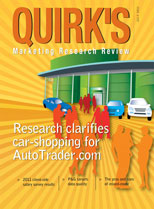Editor's note: This article appeared in the July 25, 2011, edition of Quirk's e-newsletter.
Although children may not want to hear it, retailers are shouting that it's time to go back to school. Many retailers began filling their shelves with merchandise right after the Fourth of July but with summer still in full swing more parents this year will start their shopping closer to the beginning of school, according to the 2011 back-to-school survey from the National Retail Federation, Washington, D.C., conducted by BIGresearch, Worthington, Ohio.
While most families will begin shopping three weeks to one month before school starts (42.4 percent), nearly one-third (31.2 percent) will begin their shopping one to two weeks before school starts - up from one-quarter last year. Some will get a jump start and begin shopping two months before the new school year (21.8 percent) and the remainder will shop the week school starts (2 percent) or after school starts (2.6 percent).
Value and good deals are once again of the essence in this still-sluggish economy. Parents this year will make children scour their closets before agreeing to buy any new jeans, pencils or backpacks. Families with children in grades K-12 will spend an average of $603.63 on apparel, school supplies and electronics, within a few dollars of last year's total. Total spending on grades K-12 is expected to reach $22.8 billion. Combined K-12 and college spending will reach $68.8 billion, serving as the second-biggest consumer spending event for retailers behind the winter holidays.
Although the worst of the recession is over, a shadow of insecurity still remains when it comes to how the economy will impact consumers' back-to-school plans. Americans are compensating for the economy by purchasing more store-brand or generic items (39.9 percent), comparison shopping more online (29.8 percent) and shopping for sales (50 percent). Additionally, nearly half of survey respondents said the economy is forcing them to simply spend less in general (43.7 percent).
